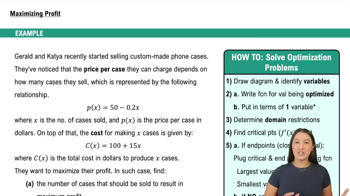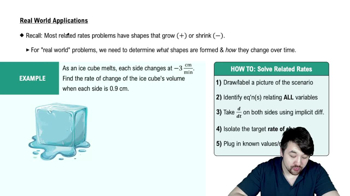Table of contents
- 0. Functions7h 52m
- Introduction to Functions16m
- Piecewise Functions10m
- Properties of Functions9m
- Common Functions1h 8m
- Transformations5m
- Combining Functions27m
- Exponent rules32m
- Exponential Functions28m
- Logarithmic Functions24m
- Properties of Logarithms34m
- Exponential & Logarithmic Equations35m
- Introduction to Trigonometric Functions38m
- Graphs of Trigonometric Functions44m
- Trigonometric Identities47m
- Inverse Trigonometric Functions48m
- 1. Limits and Continuity2h 2m
- 2. Intro to Derivatives1h 33m
- 3. Techniques of Differentiation3h 18m
- 4. Applications of Derivatives2h 38m
- 5. Graphical Applications of Derivatives6h 2m
- 6. Derivatives of Inverse, Exponential, & Logarithmic Functions2h 37m
- 7. Antiderivatives & Indefinite Integrals1h 26m
- 8. Definite Integrals4h 44m
- 9. Graphical Applications of Integrals2h 27m
- 10. Physics Applications of Integrals 2h 22m
4. Applications of Derivatives
Related Rates
Problem 107a
Textbook Question
Suppose the cost of producing x lawn mowers is C(x) = −0.02x²+400x+5000.
a. Determine the average and marginal costs for x = 3000 lawn mowers.
 Verified step by step guidance
Verified step by step guidance1
To find the average cost, use the formula for average cost: \( \text{Average Cost} = \frac{C(x)}{x} \). Substitute \( C(x) = -0.02x^2 + 400x + 5000 \) and \( x = 3000 \) into the formula.
Calculate \( C(3000) \) by substituting \( x = 3000 \) into the cost function \( C(x) = -0.02x^2 + 400x + 5000 \).
Once you have \( C(3000) \), divide it by 3000 to find the average cost for producing 3000 lawn mowers.
To find the marginal cost, first determine the derivative of the cost function \( C(x) \). The derivative \( C'(x) \) represents the marginal cost.
Calculate \( C'(3000) \) by substituting \( x = 3000 \) into the derivative \( C'(x) \) to find the marginal cost for producing the 3000th lawn mower.
 Verified video answer for a similar problem:
Verified video answer for a similar problem:This video solution was recommended by our tutors as helpful for the problem above
Video duration:
3mPlay a video:
Was this helpful?
Key Concepts
Here are the essential concepts you must grasp in order to answer the question correctly.
Cost Function
A cost function, such as C(x) = -0.02x² + 400x + 5000, represents the total cost of producing x units of a good. It typically includes fixed costs and variable costs, where the quadratic term indicates how costs change with production levels. Understanding the structure of the cost function is essential for calculating average and marginal costs.
Recommended video:

Properties of Functions
Average Cost
The average cost is calculated by dividing the total cost C(x) by the number of units produced, x. It provides insight into the cost per unit at a specific production level. For example, the average cost for producing 3000 lawn mowers can be found by evaluating C(3000) and dividing by 3000, which helps in assessing efficiency and pricing strategies.
Recommended video:

Average Value of a Function
Marginal Cost
Marginal cost refers to the additional cost incurred from producing one more unit of a good. It is derived from the derivative of the cost function, C'(x), evaluated at a specific production level. For x = 3000, calculating the marginal cost involves finding C'(3000), which indicates how production decisions impact overall costs and profitability.
Recommended video:

Example 3: Maximizing Profit
Related Videos
Related Practice






